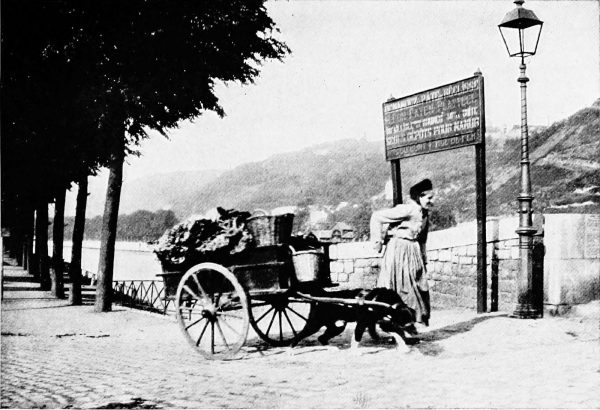
By today’s sensibilities, we may see “carting” as a fun, if not curious sport for some of our large breeds to enjoy, but the activity is historically rooted in the livelihoods of 19th and 20th century milkmen, bakers, butchers and vendors of Europe, particularly Belgium. According to Robert Leighton (1859-1934), conservative estimates put the number of carting dogs in Belgium alone in the year 1901 at 150,000 dogs working 300 days a year. There was even a National Federation for the Breeding of Draught Dogs that sought to preserve and protect these dogs as working animals.
The practice spread to England where some butchers’ carts were drawn by teams of dogs, often as many as five dogs. Both in England and on the continent, strict rules and regulations enforced by inspectors served to protect the dogs. Licenses were required, and without notice, inspectors would check the dogs at work to make sure they weren’t pregnant or nursing, or too old, young, weak, or sick to do the job. Their feet were examined for inter-digital cysts or wounds, and if any were found, they were either removed from service until their feet heeled, or they were fitted with boots. Great attention was given to the carts and harnesses. The former had to have good brakes, be well greased, enable the dog to lie down without bearing weight, and include a blanket or tarpaulin for warmth or shade, while the latter had to meet a standard of width and padding. Children under the age of 14 were forbidden to handle the dogs when they were in service, and no one could “hitch a ride,” under the direction of a minor. Dogs themselves had to meet a minimum size, and no one dog was allowed to haul over 300 pounds. It’s said that the dogs often seemed to race each other, barking all the while with excitement.
Were there abuses? No doubt, and one shudders to consider it. But it was in the best interest of owners to keep their dogs sound, and by and large, most bore considerable responsibility for their dogs. For good reason: The lower classes depended upon their dogs. They were more easily obtained than a costlier horse or donkey, more easily replaced, easily bred, easy to keep, and biddable.
In time, dog carts would be outlawed, often for specious reasons, and the outcome was horrible. Estimates place the number of dogs killed in the first year following England’s nationwide ban at about 150,000 dogs, the manner of their deaths often inhumane.
The dogs would have eventually been replaced by mechanized transportation, but today, many fanciers of those traditional carting breeds – the Newfoundland, the Bernese Mountain Dog, Greater Swiss Mountain Dog and others, have taken up carting to show that their dogs can still do the job for which they were bred.
AKC carting and drafting titles can be earned at various breed clubs (though the titles can also be earned by mixed breeds), and those interested may want to check out the American Bouvier Des Flandres Club, Bernese Mountain Dog Club, Greater Swiss Mountain Dog Club of America, Mastiff Club of America, the Saint Bernard Club of America, and the American Rottweiler Club.
Image from Wikicommons and shared under the terms of the No known copyright restrictions.

Old photo of Bernese Mountain Dogs used for pulling milk cart
How wonderful!